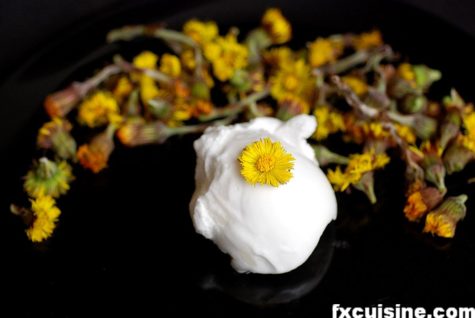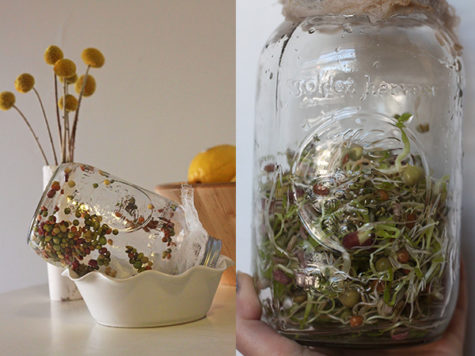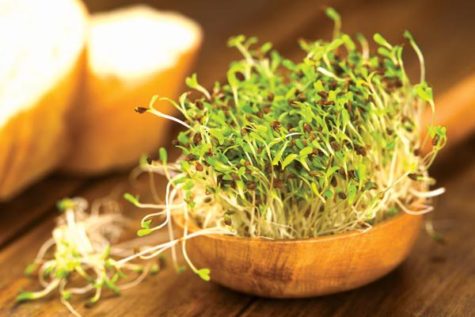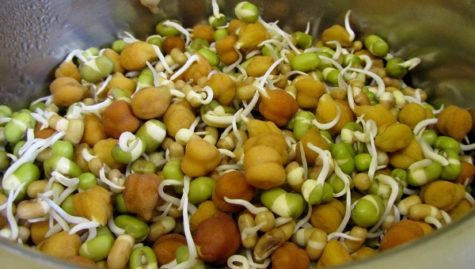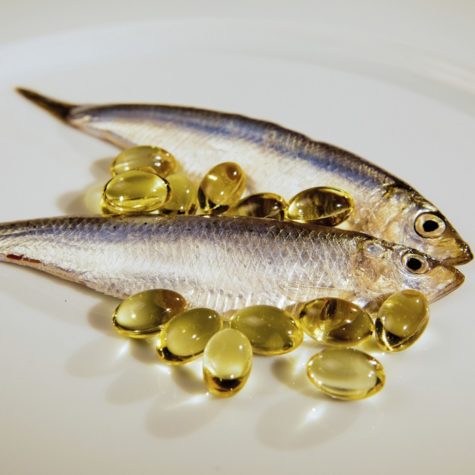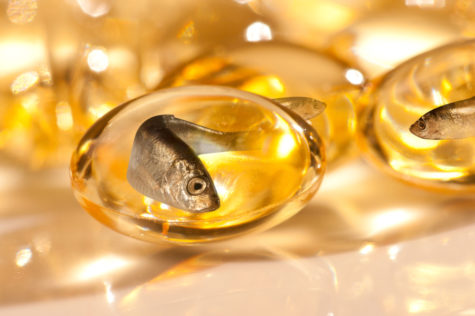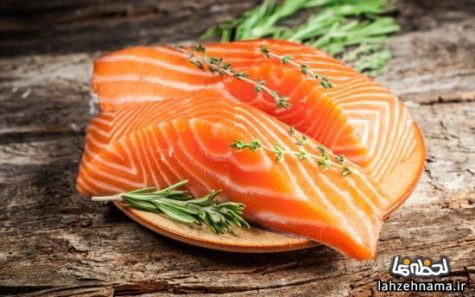Yearly Archives: 2017
Coltsfoot Sorbet
Ingredients
- 65 fresh coltsfoot flowers
- 1 cup organic cane sugar
- 3 1/3 cups water
- 1 tsp fresh squeezed lemon juice
- 1 egg white
Instructions
Make sure you have only the yellow petals from 65 coltsfoot flowers. (Remove the petals by rubbing the flowers between your thumb and forefinger. Make sure there are no green sepals in with the petals.)
Place the petals, sugar and water into a pan. Bring to a boil and cook for 2 minutes then remove from the heat and let steep for 20 minutes. Filter through a sieve and refrigerate the syrup until chilled. Add the egg white and whisk. Either place in an ice cream maker or in the freezer. As the sorbet churns, the egg white will trap air bubbles and this turns the sorbet white. If you have chosen the freezer method you will need to whisk briskly every five minutes for the first hour, then every fifteen minutes until the sorbet sets.
Note: For information on coltsfoot, including cautions and contraindications, visit The Encyclopedia of Herbology – Coltsfoot
Source: Edible Wild Food
How To Make Sprouts
Use one part seed to at least three parts water. Soak in a wide-mouth jar. All measurements below yield one quart of ready sprouts. Half-gallon or larger jars are more convenient.
- 1 cup aduki beans – soak 12 hours – 3 to 5 days to sprout
- 2 tablespoons alfalfa seed – soak 6 hours – takes 5 to 6 days to sprout
- 2 tablespoons red clover seed – soak 6 hours – takes 5 to 6 days to sprout
- 1/2 cup fenugreek – soak 8 hours – 3 days to sprout
- 1 cup garbanzo beans – soak 12 hours – 3 to 5 days to sprout
- 1 cup legumes – soak 12 hours – 3 to 5 days to sprout
- 1/2 cup lentils – soak 8 hours – 3 days to sprout
- 1/2 cup mung beans – soak 8 hours – 3 to 5 days to sprout
- 1/4 cup mustard seed – soak 6 hours – takes 5 to 6 days to sprout
- 1/4 cup radish seed – soak 6 hours – takes 5 to 6 days to sprout
- 1 cup rye – soak 12 hours – 3 days to sprout
- 1 cup soy beans – soak 12 hours – 3 to 5 days to sprout
- 2 cups sunflower seeds – soak 12 hours – 2 days to sprout
- 1 cup wheat – soak 12 hours – 3 days to sprout
Instructions:
Cover the mouth of the jar with a plastic or stainless steel sprouting screen or cheesecloth, which is tied on or secured with a rubber band (sprouting jars, bags, and automatic sprouting machines are also available).
After soaking seeds for the prescribed amount of time, drain well, and keep in a warm (65 degree F) dark place. They can be covered with a cloth or bag. Sprouting time increases with more light and cooler conditions.
Rinse twice a day, ideally morning and evening. An exception is soy, which may rot if not rinsed four times daily. Keep jar tilted mouth down for better drainage. A dish drainer works well for this. Thorough rinsing and complete draining improve sprout flavor.
After three days place alfalfa, red clover, radish, and mustard sprouts in a cool place with indirect sunlight to induce chlorophyll. Continue rinsing twice daily until sprouts are ready.
Radish and mustard seed sprouts exhibit biting pungency, which adds a delightful zesty quality when mixed with other sprouts or in various dishes.
During the sprouting process, the hulls on certain seeds slough off. It is important to remove hulls from alfalfa and radish sprouts since these easily rot. Hulls from mung, aduki, and fenugreek are often removed for a lighter-tasting quality, although they can be eaten and provide fiber.
To remove the loose hulls from sprouts, place them in a large bowl of water and agitate them, further loosening and brushing them aside. Gently reach under the sprouts and lift them out of the water, without disturbing the sunken hulls, which can then be discarded.
Drain sprouts well. If refrigerated, they keep up to one week in a plastic bag or covered glass jar.
Note:
Alfalfa may not sprout in polluted tap water. Use distilled or spring water or sprout with other seeds (mung, lentil, fenugreek) in the same jar. You will have a delicious salad. Save all rinse water for cooking, watering plants, or to give your animals.
From: Healing With Whole Foods
Alfalfa Sprouts
Alfalfa is America’s favorite sprout and is considered more nutritionally concentrated than other sprouts, primarily because of its rich mineralization. The tiny alfalfa seed produces a root that can reach 100 feed into the earth, where it has access to minerals and trace elements untouched by other plants.
Alfalfa follows the doctrine of signatures: its ability to produce exceptional roots benefits our “roots,” which are often identified physiologically as our intestines and kidney/bladder functions.
Arabs were the first to discover alfalfa and found it a highly strengthening food, both for themselves and their race horses. Because of its attributes, they named it al-fal-fa, which means “father of all foods.”
From: Healing With Whole Foods
About Sprouts
Sprouts represent the point of greatest vitality in the life cycle of a plant. One clearly experiences this vitality when eating sprouts consistently. During sprouting, vitamin and enzyme content increases dramatically. At the same time starch is converted into simple sugars, protein is turned into amino acids and peptones, and crude fat is broken down into free fatty acids. Hence, the sprouting process predigests the nutrients of the seed, making it easier to assimilate and metabolize. This explains why grains and legumes, many of which are common allergens, often do not cause allergies when sprouted.
Nevertheless, the sprouting process increases the cooling attributes of the seed, which can over-cool the cold person and weaken digestion in those with low “digestive fire.” Generally if one is frail, feels cold often and/or tends toward loose stools, then sprouts must be eaten sparingly. Cooking makes sprouts more appropriate for these individuals. On the other hand, the excessive person (robust body and personality, thick tongue coating, ruddy complexion, strong radial pulse and voice) will benefit from abundant raw or lightly cooked sprouts.
In Chinese medicine, sprouts are a specific remedy for cases of stagnant liver qi (with signs such as swellings and lumps, mental depression, frustration, swollen abdomen and chest, purple-tinged or dark tongue, and/or greenish complexion).
During cold seasons, sprouts act as an excellent source of fresh vegetables. Cooking them at this time of the year balances their cooling nature. In fact, in China where sprouts have thousands of years of traditional use, they are routinely cooked. Raw sprouts have been desirable in the West because they more efficiently reduce the massive excesses occurring among the general population.
For better digestion for every type of person, large grain and legume sprouts such as aduki, lentil, corn, green peas, soy, garbanzo, and wheat can be lightly steamed and are still vital and energizing. They need to be simmered, sauteed, or steamed longer fore people who are cold or deficient.
The growth characteristics of sprouts are most appropriate for attuning one to the energetic upsurges of spring and summer.
From: Healing With Whole Foods
Where To Get The Most Omega-3s
You usually find the most omega-3 fat in the fattiest fish from the coldest deep sea. Richest sources are:
- Mackerel
- Anchovies
- Herring
- Salmon
- Sardines
- Lake trout
- Atlantic sturgeon
- Tuna
Moderate amounts are found in the following:
- Turbot
- Bluefish
- Striped bass
- Shark
- Rainbow smelt
- Swordfish
- Rainbow trout
Shellfish – crab, lobster, shrimp, mussels, oysters, clams and squid – contain lesser amounts of omega-3s.
To get the most omega-3 benefits, bake or poach fish. Frying or otherwise adding fat, especially vegetable oils high in omega-6s, decreases the omega-3 potency in the fish.
Choose tuna packed in water and sardines canned without oil, unless it is a sardine oil, noted on the label as sild Added oils, such as soybean oil, can diminish the omega-3s. Also, draining oil from the canned tuna washes away from 15 to 25 percent of the omega-3s, whereas draining water off washes away only 3 percent.
You can also get some omega-3s in certain plant foods. The highest concentrations are in walnuts, flaxseed and rapeseed (from which canola oil is made) and purslane, a green leafy vegetable that grows wild in the United States and is commonly eaten in Europe and the Middle East. However, plant omega-3s appear to be only one-fifth as potent as marine omega-3s in fostering beneficial reactions in cells.
From: Food Your Miracle Medicine
Fish Oil For Prevention
The following is a list of various disorders that fish oil may alleviate or prevent:
- Rheumatoid arthritis: Reduces joint pain, soreness, stiffness, fatigue.
- Heart attacks: Cuts the odds of subsequent heart attacks by one-third.
- Clogged arteries: Keeps arteries open and clear. Eaters of fatty fish have less atherosclerosis. Reduces risk of reclosure of arteries after angioplasty surgery by 40 to 50 percent.
- High blood pressure: Eliminates or reduces the need for pharmaceutical pressure-lowering medications.
- Ulcerative colitis (inflammatory bowel disease): In one test, eating 4.5 grams of fish oil a day – equal to that in seven ounces of mackerel – for eight months depressed disease activity by 56 percent.
- Psoriasis: Reduces itching, redness, pain in some patients, and cuts the amount of medication needed.
- Multiple sclerosis: Helps reduce symptoms in some patients.
- Asthma: Curtails attacks in some individuals.
- Migraine headaches: Lessens severity and frequency in some sufferers.
From: Food Your Miracle Medicine
The Lifesaving Power of Fish
“Our epidemic of heart disease and cancer may be the result of a human fish oil deficiency state so enormous we fail to recognize it.”
~Ewan Cameron, MD
New research underscores the enormous lifesaving power of fat in fish. Eating fatty fish can directly intervene to save people from death and disability from heart attacks. Studies have found that atherosclerosis – diseased and clogged arteries – worsens, the less marine oil a person eats.
Dr. William E. M. Lands,a pioneering researcher on fish oils, has developed a formula that he says can precisely predict an individual’s odds of heart attack; a simple finger-prick test measures a person’s blood ratio of omega-3 and omega-6 fatty acids. The higher the proportion of marine omega-3s to omega-6s, the lower the risk of heart attack. Similarly, studies reveal that a high ratio of omega-3 fatty acids to omega-6 fatty acids in the blood cuts your chances of cancer.
Although it’s largely unappreciated, our over-consumption of omega-6 oils, prevalent in margarine, salad oil, cooking oil and processed food, is helping create a health disaster. It is true, heart authorities first encouraged the widespread use of such vegetable oils to lower blood cholesterol, not suspecting the oils could have detrimental effects on other aspects of health, such as fostering inflammatory diseases, lowering immunity and promoting cancer. Such omega-6 oils are well-documented villains in augmenting cancer incidence, cancer spread and deaths in laboratory animals.
The only way to correct this abnormal and alarming fat imbalance in cells is to cut back drastically on foods rich in omega-6s and increase the intake of marine omega-3s, say experts. The impact is almost immediate. Within 72 hours, you can see a beneficial biochemical impact in tissue by eating three and a half ounces of fish a day, studies indicate.
It is smart to eat fish, especially fatty fish such as salmon, sardines, mackerel, herring and tuna, at least two or three times a week. However, adding any amount of seafood to a seafood-poor diet can readjust our fatty acid balance somewhat, helping curtail not only heart disease, but the many modern disorders linked to a “seafood fat deficiency.”
Research shows that eating just an ounce of fish a day may help restore our cells to healthy functioning, saving countless people from disability and premature death inflicted by the unimagined consequences of fat’s pharmacological powers.
From: Food Your Miracle Medicine
You Are The Fat You Eat
Very quickly after you eat fat, it shows up in the membranes of your cells where its metabolic fate is determined. Although fatty acids come in many subtle variations of molecular arrangement, two major categories are most important in making elcosanoids, (a family of powerful, hormone-like compounds produced in the body from Essential Fatty Acids).
These two major categories are omega-3 fatty acids, concentrated in marine life as well as a few land plants, and omega-6 fatty acids, concentrated in land-based vegetable oils such as corn oil, safflower and sunflower oil, as well as in animal foods raised on land-based feeds.
When you consume land-based omega-6 fatty acids from a piece of meat or corn oil, they are apt to be changed into a substance called arachidonic acid, which in turn spawns substances that are highly inflammatory or promote blood stickiness and blood vessel constriction. Fat from seafood is radically different and more benign. Its omega 3 fatty acids are apt to be converted into substances that counteract blood platelet clumping, dilate blood vessels and reduce inflammation and cell damage.
Since food is made of mixtures of omega-3s and omega-6s, obviously these two fatty acids are continuously giving contradictory instructions to cells. Which prevails – those for health or those for disease – depends on the ratio of the two fatty acids in your diet and hence your cells, says William E. M. Lands, PhD., a pioneering researcher on fish oils and formerly a professor of biochemistry at the University of Illinois at Chicago.
If your cells are flooded with omega-6 fatty acids, the resulting oversupply of overactive prostaglandins is apt to run amok, generating disease. If you have sufficient omega-3 fatty acids, they can check or cool down the archidonic engine that is spewing out the disease-producing eicosanoids.
From: Food Your Miracle Medicine
The End of All Diets
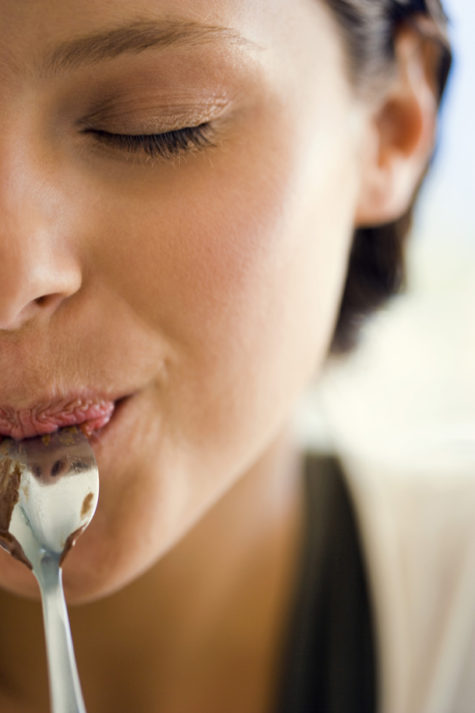
Our tendency is to eat automatically, robot-like. If the taste is not lived, we are just stuffing. Go slow and be aware of the taste. Only when you go slow can you be aware. Taste the food unhurriedly and become the taste. When you feel sweetness, become the sweetness. Then it can be felt all over the body, spreading in ripples.
When and Where:
Whatsoever and whenever you are eating, feel the taste and become the taste. When drinking water, feel the coolness. Close your eyes, drink it slowly, taste it.
Benefits:
With this technique your sensitivity grows, and you become more alive and more filled. Stuffing disappears as the whole of your body feels
filled. The more sensitive you are the more alive you are. When you are more alive, more life will enter your inner being. You will be more open.
Source: Pragito Dove
Summer Tea
This tea is refreshing on any warm day or after exertion in the garden. It is equally pleasant hot or cold.
- 2 tsp hibiscus flowers
- grated peel of ½ a lemon (optional)
- grated peel of ½ a lime (optional)
Note:
This blend is for one person and is intended to have half a pint of boiling water poured over it. Allow the infusion to stand for 10 minutes before straining and do not stir, as this bruises the plants. Obviously, you can adjust the amount of water or standing time to your own taste. If you prefer your tea sweet, add a little honey, not sugar, to the strained infusion.
